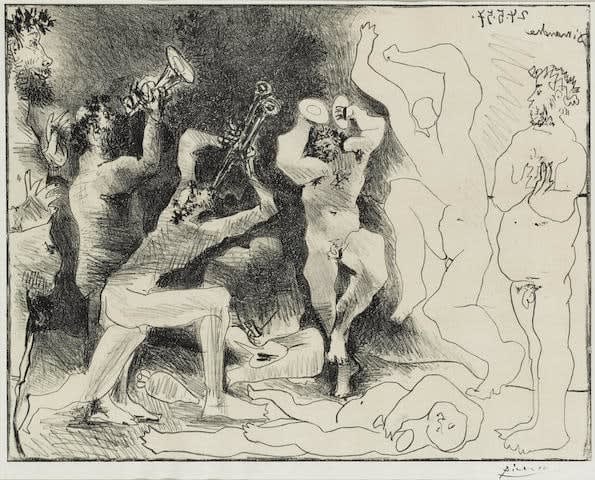Pablo Picasso Spanish, 1881-1973
La danse des faunes, 1957
Lithograph on Arches paper
Artist's signature stamped, lower right on recto
Artist's signature stamped, lower right on recto
Image: 41.2 x 53 cm
Sheet: 48.2 x 63.5 cm
Sheet: 48.2 x 63.5 cm
© Pablo Picasso
In the twentieth century Picasso was especially fascinated by the lustful and voyeuristic nature of satyrs (and their Roman equivalent, fauns), and many of his drawings of them have been...
In the twentieth century Picasso was especially fascinated by the lustful and voyeuristic nature of satyrs (and their Roman equivalent, fauns), and many of his drawings of them have been published. Examples (copies in Cambridge, Massachusetts) include Satyr Dévoilant une Femme (from the Vollard suite, 1936); Les Faunes et la Centauresse (1947); Faune Musicien (1948); La Danse des Faunes (1957).
A prolific and tireless innovator of art forms, Pablo Picasso (1881–1973) impacted the course of 20th-century art with unparalleled magnitude. Inspired by African and Iberian art and developments in the world around him, Picasso contributed significantly to a number of artistic movements, notably Cubism, Surrealism, Neoclassicism, and Expressionism. Along with Georges Braque, Picasso is best known for pioneering Cubism in an attempt to reconcile three-dimensional space with the two-dimensional picture plane, once asking, “Are we to paint what’s on the face, what’s inside the face, or what’s behind it?” Responding to the Spanish Civil War, he painted his most famous work, Guernica (1937), whose violent images of anguished figures rendered in grisaille made it a definitive work of anti-war art. “Painting is not made to decorate apartments,” he said. “It’s an offensive and defensive weapon against the enemy.” Picasso’s sizable oeuvre includes over 20,000 paintings, prints, drawings, sculptures, ceramics, theater sets, and costume designs.
A prolific and tireless innovator of art forms, Pablo Picasso (1881–1973) impacted the course of 20th-century art with unparalleled magnitude. Inspired by African and Iberian art and developments in the world around him, Picasso contributed significantly to a number of artistic movements, notably Cubism, Surrealism, Neoclassicism, and Expressionism. Along with Georges Braque, Picasso is best known for pioneering Cubism in an attempt to reconcile three-dimensional space with the two-dimensional picture plane, once asking, “Are we to paint what’s on the face, what’s inside the face, or what’s behind it?” Responding to the Spanish Civil War, he painted his most famous work, Guernica (1937), whose violent images of anguished figures rendered in grisaille made it a definitive work of anti-war art. “Painting is not made to decorate apartments,” he said. “It’s an offensive and defensive weapon against the enemy.” Picasso’s sizable oeuvre includes over 20,000 paintings, prints, drawings, sculptures, ceramics, theater sets, and costume designs.
Join our mailing list
* denotes required fields
We will process the personal data you have supplied to communicate with you in accordance with our Privacy Policy. You can unsubscribe or change your preferences at any time by clicking the link in our emails.
